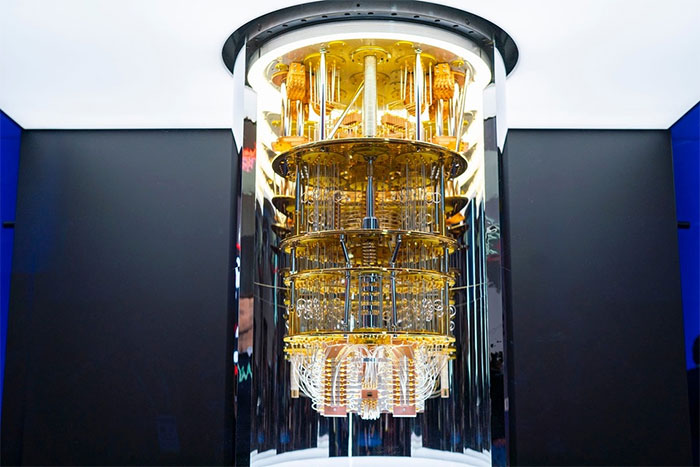The most powerful computer in the world
Quantum computing systems with hundreds of thousands to millions of qubits are being developed by IBM and Google, expected to be completed in the next 10 years.
Late last year, IBM set the record for the largest quantum computer with a processor of 433 quantum bits, or qubits, the units of quantum information processing. At the G7 summit, the company announced an even bigger ambition: to complete a 100,000-qubit computer within the next 10 years.
IBM says it will spend $100 million to create a supercomputer capable of solving problems that no other supercomputer can solve. The idea is to use this 100,000 qubit computer, combined with the best supercomputers, to create new drugs, new fertilizers, new battery compounds and a host of other applications.
Quantum computing processes information by exploiting the properties of elementary particles. Electrons, atoms, and small molecules can exist in multiple energy states at the same time, a process called superposition, and the states of the particles can be linked together. Each qubit can exist in both 0 and 1 states at the same time, instead of 0 or 1 like a conventional computer bit, which allows multiple calculations to be performed at the same time.

IBM's quantum computer. (Photo: IBM).
Million qubit quantum computer
Despite their promise, quantum computers have yet to do anything useful that conventional supercomputers can't do. That's because they don't have enough qubits, and quantum computing systems are easily disrupted by small disturbances called noise.
Researchers predict that quantum computing systems will have to scale up significantly, so that they can devote a large fraction of qubits to correcting errors caused by noise.
So the number of qubits alone does not determine the capabilities of a quantum computer. There are also specific details about how the qubits are built, how they can be corrected for errors due to noise, and how they can be operated in practice.
IBM isn't the only company aiming high. Google says it wants to create a quantum computer with a million qubits by the end of the decade, with only 10,000 qubits for calculations and the rest for error correction.
IonQ is aiming to have 1,024 'logical qubits' , each made up of an error-correcting circuit of 13 physical qubits, by 2028. PsiQuantum, like Google, is also aiming to build a million-qubit quantum computer, but has not disclosed timelines or error-correction configurations.
There is no guarantee of success.
IBM's qubits are currently made of superconducting metal rings, which resemble atoms when operating at millikelvin temperatures, just a little above absolute zero, or -273 degrees Celsius. IBM says that qubits of this type can only scale up to 5,000 qubits with current technology, which isn't large enough to provide much computational benefit.
Currently, each of IBM's superconducting qubits requires about 65 watts to operate. At 100,000 qubits, it would take a nuclear power plant to power the machine and billions of dollars to develop it. Jay Gambetta, vice president of IBM's quantum computing division, said the company plans to use 'complementary metal-oxide semiconductor ' (CMOS) technology that can be installed next to the qubits to operate them with just tens of milliwatts of power.
CMOS is still in the experimental stage and the technologies needed for quantum supercomputers don't exist yet, Gambetta admits.
There's no guarantee that the $100 million spent on the project will be enough to build a 100,000 qubit computer. 'There's definitely a risk,' Gambetta said.
'It's not going to be a completely smooth journey,' said Joe Fitzsimons, CEO of Horizon Quantum, a Singapore-based quantum software developer.
IBM's plan seems plausible, Fitzsimons said, although there are potential hurdles. 'At this scale, it would be very difficult to develop control systems that could operate such a large number of qubits efficiently ,' he said.
- China makes the world's most powerful supercomputer
- The world's most powerful new supercomputer
- China claims to own the world's most powerful quantum computer system
- China leads the top 500 most powerful supercomputers in the world
- NASA revealed that Google is about to build the world's most powerful computer
- Google makes quantum computers, a billion times stronger than the current most powerful supercomputers
- America is once again the country with the most powerful supercomputer in the world
- 40 minutes only simulates 1 second of the human brain
- Accidentally discovered the world's first computer after more than 50 years
- Watson supercomputer takes on the role of chef
- Visit the computer mouse breeding area of the European Atomic Research Organization
- Super computer simulates human heart
 The US company is about to build a supersonic passenger plane of 6,000km / h
The US company is about to build a supersonic passenger plane of 6,000km / h Japan develops avatar robot as in fiction film
Japan develops avatar robot as in fiction film Australia tested the world's first mango picking robot
Australia tested the world's first mango picking robot America develops technology to separate water from animal waste
America develops technology to separate water from animal waste China produces -273 degree C quantum computer refrigerator
China produces -273 degree C quantum computer refrigerator  The Secret Behind Quantum Entanglement: Have Aliens Really Visited Earth?
The Secret Behind Quantum Entanglement: Have Aliens Really Visited Earth?  The greatest contradiction of contemporary physics, Albert Einstein spent half his life but could not solve it
The greatest contradiction of contemporary physics, Albert Einstein spent half his life but could not solve it  China has successfully built the first quantum engine using quantum entanglement.
China has successfully built the first quantum engine using quantum entanglement.  China 'unveils' 504 qubit superconducting quantum computer
China 'unveils' 504 qubit superconducting quantum computer  The first quantum gravity meter appears, revealing the secret map of the underground world!
The first quantum gravity meter appears, revealing the secret map of the underground world! 